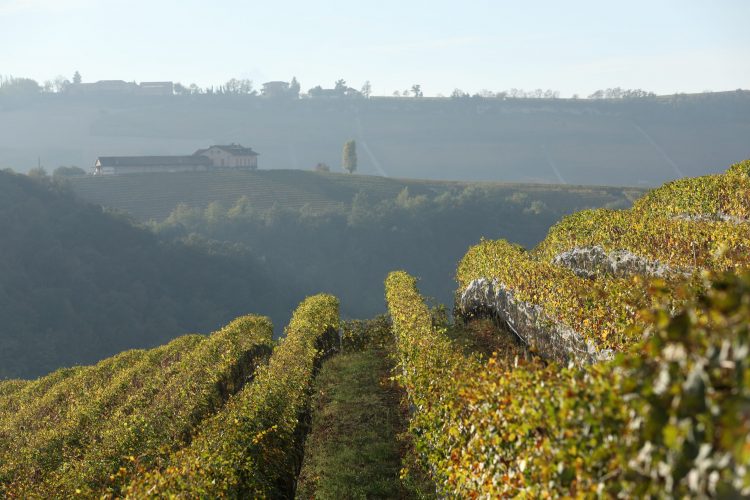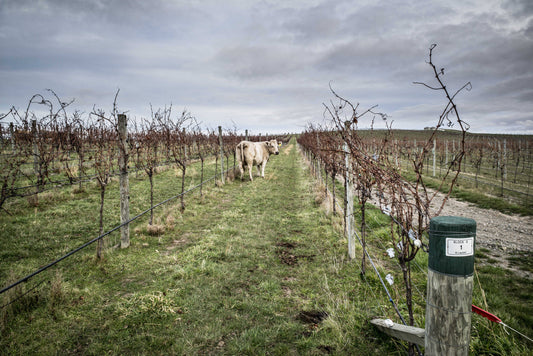| The Bussia vineyard district, located mostly in the township of Monforte d’Alba, is arguably one of the five greatest sites in all of Barolo, and its wines have long enjoyed a lofty reputation. However, not all is fine and dandy with this hallowed vineyard district, and speaking about its merits and characteristics is both easy and difficult at the same time. Easy? Yes, because Bussia’s greatness cannot be denied: it was the first ever Barolo cru to be vinified as a single-district wine. (Barolo crus are too vast to be considered single vineyard areas, but are rather series of vineyard plots belonging to one district, officially been defined as Menzioni Geografiche Aggiuntive or MGA for short.) It was Beppe Colla, then working at the Prunotto estate, who placed the name ‘Bussia’ on his 1961 Barolo. Prior to that time, the tradition in Barolo had been to blend grapes from many different townships in order to make the best possible wine each year. The fact that Beppe Colla (one of the greatest experts of Langhe vineyards and one of its best winemakers) chose the grapes from this specific vineyard to be his first ever cru-designate wine speaks volumes about the high esteem in which he (and everyone else) has always held Bussia. Colla proceeded to use the name Bussia at a time when practically nobody else was thinking of doing so because he was convinced his wine that year would be better than the ‘traditional’ blend. His decision was certainly an indicator of the greatness of this cru, but there are other indicators too, not least the many magnificent wines made over the years by Aldo Conterno and his family – Barolos labelled not just as Bussia but from specific sites such as Colonnello, Cicala and the particularly magnificent Romirasco. Difficult? In typical Italian fashion, yes, unfortunately so. This because ever since 2010 when the official Bussia MGA was created, its boundaries have been enlarged to a near-ridiculous degree. Today, the Bussia MGA covers about 300 hectares, an area too large, no matter how you look at it. As Ian d’Agata astutely compared in Italy’s Native Wine Grape Terroirs (UC Press 2019), the Burgundy grand cru Musigny covers less than 11 hectares, and considering that the entire Barolo denomination is about 1,800 hectares, this means that the area of Bussia is around 17% of the entire Barolo denomination. Clearly, it is impossible for vineyards over an area this size to yield wines of similar quality level. The wide range of altitudes (from 220 to 460 metres), exposures (from south to southwest-facing slopes for the best parcels; east- to west-facing for the others) and lithology (sandstones of Diano characterize the highest plots, while Sant'Agata Fossil Marls are generally more abundant in other parts of Bussia), makes it difficult to speak of Bussia as a whole, or at least, as it has been defined since 2010. Simply put, the official Bussia cru as it stands today exists on too large a scale. Taking the first map of Barolo (Renato Ratti, 1965) as a reference, only a few of the vineyards that are now part of Bussia were viewed as ‘historic wine-growing sub-areas of traditional vocation’ offering ‘particular qualitative characteristics’. These were: Bussia Soprana (in which the famous vineyard plots of Cicala, Colonnello, Romirasco and Gabutti are found), Bussia Sottana, Arnulfo, Dardi (and Mondoca), Fontanile (Munie), Pian della Polvere and Pugnane. Each one of these sites gives wondrously different Barolos, even when similar winemaking techniques are used, so it is hard to say that they should speak of ‘one’ Bussia. And yet it is from those historical sub-zones, and – like it or not – not from others, that Bussia delivers the most refined of all Monforte Barolos, combining elegance, balance and longevity like few other Barolos. Wines that fall somewhere in between the refined austerity of Serralunga and the graceful charm of La Morra, and boasting the peculiar refreshing balsamic note for which Monforte Barolos are famous. In light of this, I would say that some reconsideration of Bussia’s official boundaries is probably warranted. Certainly, the word ‘Bussia’ on the label is, from a marketing point of view, an added value for both wine and producer, but whether the word Bussia holds much indication of the characteristics of the wines and, to quote Matt Kramer, delivers a ‘Bussia-somewhereness’ in every glass, is, at the present time, questionable. My favourites: Poderi Aldo Conterno: Barolo Bussia Vigna Romirasco and Barolo Riserva Granbussia Poderi Colla: Barolo Bussia Dardi Le Rose Oddero Poderi: Barolo Bussia Vigna Mondoca Riserva Fenocchio Claudio: Barolo Bussia and Barolo Bussia 90 Dì Riserva | ||
| AUTHOR Michele Longo is a Certified Sommelier and teacher. He writes for Barolo & Co magazine and is co-curator (with Ian d’Agata) of the Italy Section of Hugh Johnson’s Pocket Wine Book. Michele’s latest book (also with Ian D’Agata) is Barbaresco and Barolo: Listening to Nebbiolo and its Langhe Terroirs is published later this year. |
FACT FILE PiemonteGeography: Located in the northwest corner of Italy, Piedmont borders west with France. It is surrounded by large Alpine masses (north and west) and the Apennines (south) that influence the typically continental climate, characterized by wide thermal excursions between day and night, relatively cold and damp winters, and hot, humid summers. Grape varieties: Red: Nebbiolo, Barbera, Dolcetto, Freisa, Brachetto and Grignolino. White: Moscato, Cortese, Arneis, Erbaluce and Timorasso Viticulture: With over 40,000 hectares (100,000 acres) under production, 17 DOCGs and 42 DOCs, Piedmont is the region with Italy’s greatest number of vineyard designations – its wiens significant on both the local and international markets. The vineyards are mostly red grapes, with some noteworthy native and international white grapes grown as well. Winemaking: More than 90% of the region's wine production occurs in the hilly areas, with modern vine-training systems such as Guyot. ‘Identity’ and ‘terroir’ are probably the two keywords here now, after years in frantic pursuit of ‘international’ taste. Regions: Alto Piemonte, with the ‘Northern’ Nebbiolos (Lessona, Gattinara, Boca, Ghemme); Langhe and Roero, for the Nebbiolo wines of Barolo, Barbaresco and Roero (also high quality Dolcetto, Barbera and more); Monferrato and Astigiano (well-known for Barbera, Ruchè and Moscato d'Asti) and Tortonese and Gavi (known for Timorasso and Cortese) |
Barolo Bussia: in Praise of Balance!



